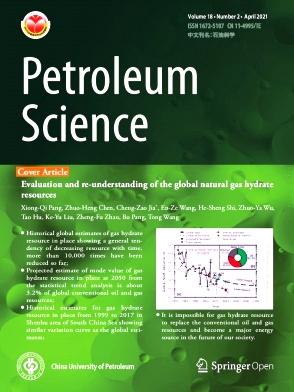A novel self-rotating down-the-hole hammer with impact and rotary functions for directional drilling: Design, modeling, and experiments
IF 6
1区 工程技术
Q2 ENERGY & FUELS
引用次数: 0
Abstract
Pneumatic down-the-hole hammer, serving as rock-breaking tool, possesses appeal for directional drilling due to its high rate of penetration. However, corresponding experimental studies on existing hammers for directional drilling have rarely been reported, and a model for evaluating their output performance is absent. This study proposes a novel structure of self-rotating pneumatic hammer (NSH) with a built-in rotational mechanism, which converts partial impact energy of the piston to rotate the drill bit and, consequently, enables dual functions of impact and rotate drill bit. The energy is converted via a screw key-groove mechanism, and the wedge-shaped teeth mechanism ensures that the drill bit rotates clockwise during the piston moves downward. The computational fluid dynamics method is applied to simulate the dynamic response of airflow and piston during the operation of Φ127NSH. Meanwhile, a test bench is established to record data concerning chamber pressure and piston displacement, as well as recording its operational status and rock fragmentation during drilling into granite. The results showed that the maximum error between simulated and experimental data is 8.2%. The Φ127NSH successfully achieves dual impact and rotary drilling functions, and granite smoothly feeds and forms a continuous shear rock zone. In addition, the effects of torque load, engagement distance in rotation sleeves, and well deviation angle towards the performance of NSH were studied in detail. The designed Φ127NSH operates at an impact velocity of 3.98 m/s, impact frequency of 12.55 Hz, and rotational speed of 29.51 r/min under a mass-flow rate of 0.18 kg/s, torque load of 400 N·m, engagement distance of 40 mm, and well deviation angle of 0°. The torque load adversely affects the NSH output performance. Increasing the engagement distance improves impact performance while reducing rotational performance. The performance variation of the NSH is minimal when drilling directional wells with varying deviation angles.
求助全文
约1分钟内获得全文
求助全文
来源期刊

Petroleum Science
地学-地球化学与地球物理
CiteScore
7.70
自引率
16.10%
发文量
311
审稿时长
63 days
期刊介绍:
Petroleum Science is the only English journal in China on petroleum science and technology that is intended for professionals engaged in petroleum science research and technical applications all over the world, as well as the managerial personnel of oil companies. It covers petroleum geology, petroleum geophysics, petroleum engineering, petrochemistry & chemical engineering, petroleum mechanics, and economic management. It aims to introduce the latest results in oil industry research in China, promote cooperation in petroleum science research between China and the rest of the world, and build a bridge for scientific communication between China and the world.
 求助内容:
求助内容: 应助结果提醒方式:
应助结果提醒方式:


